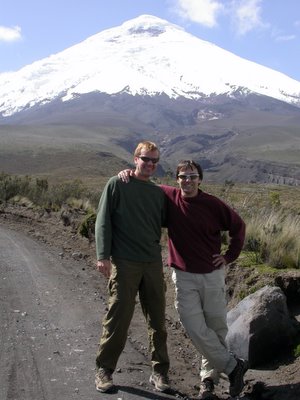
Hooray! The wonderful folks at blogger.com were able to restore our blog after Rick accidently deleted it.
We just returned to Quito from Cotopaxi, which at over 19,000 feet is the highest active volcano in the world (pictured above). We got a ride up Cotopaxi to just below the snow line and then went down it by mountain bike. 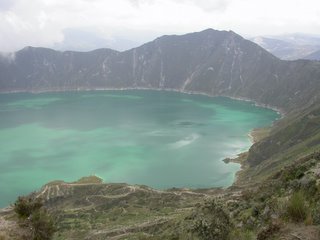
On the second day, we went with a wonderful Canadian couple, Brett and Corrie Olsen, to the crater lake of Quilatoa volcano. The highly alkaline water in the lake is a brilliant emerald green. There is a trail around the rim and a couple that lead into the crater. It was pretty easy to climb down into the crater, but it was really tough getting back out, especially when the afternoon rain set it. The altitude here is about 15,000 feet. whew!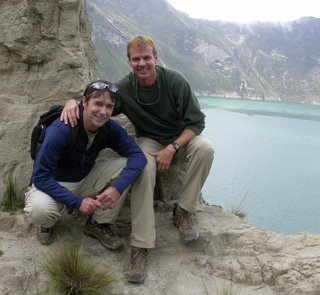
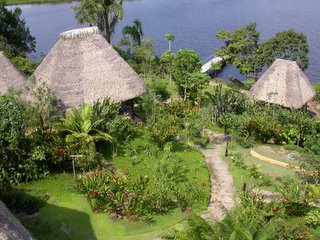
The previous week, while our blog was down, we stayed in the Amazon rainforest at the incredibly remote Napo Wildlife Center. There was a great variety of birds, monkeys, insects, and plant and water life. The guides were really happy to see us, since almost all the people who come here are too old to go on the really interesting trails, which can be physically challenging. On one trail we saw an eagle that even the guide, who has worked here for 7 years, had never seen. We saw more wildlife in this area than either of us have seen in other places combined. One night after our hike ended at dark, we paddled in a small stream with fishing bats flying around and caimans eyeing us a couple feet away among other interesting nocturnal creatures. Napo is one of only a few places in Ecuador where parrots come to eat the clay in order to detoxify poisons in their diet.

Above, parrots at a clay lick by the Napo River. On the right, our guide talks to Gary as we paddle in dugout canoes for an hour and a half through the Amazon rainforest to reach the lodge. This was after two and a half hours by motored canoes down the Napo River. Along the way a group of 20-30 squirrel monkeys followed along jumping from tree to tree. Snail kites were as common as the mosquitoes along this creek. Okay, maybe not THAT common but there were many of them. The water here is called "black water" because of a high tannin content from the surrounding plant life. Mosquitoes dislike breeding in black water, so they were not as plentiful as you might think for this part of the world.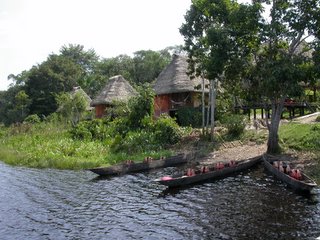
Our terrific guide, David, and Rick helped a dog at one of the clay licks. She had an infestation of worm-like fly larvae in her volva. These larvae are about half the length and girth of a child´s thumb and they litterly feed on the dog´s flesh in order to grow. Since the removal of these larvae are uncomfortable for the dog (but an extreme relief afterwards), we flipped her on her back and Rick kneeled over her head, keeping her mouth closed with his tighs and still having free hands to help remove the larvae. David pinched her flesh where the larvae was, forcing out its head. Rick then grabbed the head with a leaf and slowly pulled it out, all the while keeping the dog´s mouth from squirming out from between his thighs. We removed 11 larvae in about 30 minutes and basically saved the dog´s life.


2 Comments:
How do those parrots know to eat the clay? So glad you got the Blog back. I've been traveling along with you as I read about property in Panama and Nicaragua primarily. Seriously planning to re-locate as soon as possible.
Charles, Richard and I will warm your home next Saturday with a dinner party as I'm in town from Edwards for some work and fun.
I'm glad you did not wait to do this journey too...so much to see.
I'm going to look more closely at Equador too.
Love Todd
Hey Todd - I´m pretty sure that the parrots learn this behavior, at least in part, rather than inherit it. The reason I say this is because the guide said that the parents fly with their children to the clay lick so that the kids will know where it is.
Of course, there is probably inherited behavior as well. If a parrot doesn´t like clay licks, then he either will not eat as much fruit or will be more debilitated by toxins than a parrot who does like clay licks. So, over time, the parrots that like clay licks are more likely to survive and pass this behavorial trait to the next generation.
I´m glad you are enjoying the blog! Love, RIck
Post a Comment
<< Home